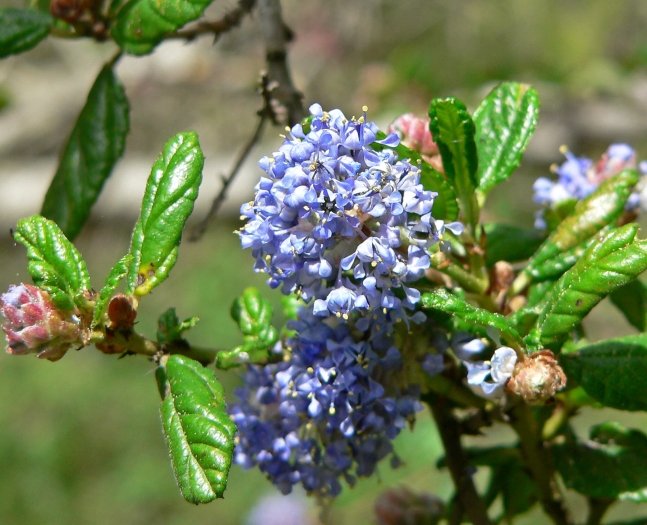Santa Barbara Ceanothus
(Ceanothus impressus)
Santa Barbara Ceanothus (Ceanothus impressus)
/
/

Stan Shebs
CC BY-SA 3.0
Image By:
Stan Shebs
Recorded By:
Copyright:
CC BY-SA 3.0
Copyright Notice:
Photo by: Stan Shebs | License Type: CC BY-SA 3.0 | License URL: https://creativecommons.org/licenses/by-sa/3.0 | Uploader: Stan Shebs | Publisher: Wikimedia Commons | Title: Ceanothus_impressus_var_nipomensis_2.jpg | Notes: |






















Estimated Native Range
Summary
Ceanothus impressus, commonly known as Santa Barbara Ceanothus, is an evergreen shrub native to the coastal chaparral and foothill woodlands of California, particularly in the Santa Barbara region. It typically grows to a height of up to 3 meters with a dense or open form that can be quite variable. The leaves of Santa Barbara Ceanothus are distinctive, being about 2 centimeters long, oval-shaped, highly ridged, and wrinkled, with edges that curl under. They often feature gland-dotted surfaces and grayish hairy undersides, which contribute to the plant’s drought resistance by reducing water loss. From late winter to early spring, the shrub produces abundant inflorescences of small but showy blue flowers, which are highly attractive to pollinators such as bees and butterflies. The fruit is a crested spherical capsule about 4 millimeters wide, which adds to the plant’s ornamental value.
Santa Barbara Ceanothus is valued for its drought tolerance and ability to thrive in poor soils, making it an excellent choice for water-wise gardens and native plant landscapes. It is often used for slope stabilization, as a hedge or screen, and in naturalistic plantings. This species prefers full sun but can tolerate some shade, and it requires well-drained soils. While it is adapted to low water conditions, occasional deep watering during prolonged dry periods can help maintain its vigor. It is important to avoid overwatering, as this can lead to root rot. Gardeners should be aware that Ceanothus can be susceptible to fungal diseases if conditions are too moist or if there is poor air circulation.CC BY-SA 4.0
Santa Barbara Ceanothus is valued for its drought tolerance and ability to thrive in poor soils, making it an excellent choice for water-wise gardens and native plant landscapes. It is often used for slope stabilization, as a hedge or screen, and in naturalistic plantings. This species prefers full sun but can tolerate some shade, and it requires well-drained soils. While it is adapted to low water conditions, occasional deep watering during prolonged dry periods can help maintain its vigor. It is important to avoid overwatering, as this can lead to root rot. Gardeners should be aware that Ceanothus can be susceptible to fungal diseases if conditions are too moist or if there is poor air circulation.CC BY-SA 4.0
Plant Description
- Plant Type: Shrub
- Height: 6-8 feet
- Width: 8-10 feet
- Growth Rate: Moderate
- Flower Color: Blue, Purple
- Flowering Season: Spring
- Leaf Retention: Evergreen
Growth Requirements
- Sun: Full Sun, Part Shade
- Water: Low
- Drainage: Medium
Common Uses
Bank Stabilization, Bee Garden, Bird Garden, Border Plant, Butterfly Garden, Drought Tolerant, Fragrant, Hummingbird Garden, Low Maintenance, Salt Tolerant, Showy Flowers, Street Planting
Natural Habitat
Coastal chaparral and foothill woodlands of California
Other Names
Common Names:
Scientific Names: , Ceanothus impressus, Ceanothus impressus var. impressus, Ceanothus dentatus var. impressus, Ceanothus impressus var. niponensis,
GBIF Accepted Name: Ceanothus impressus Trel.